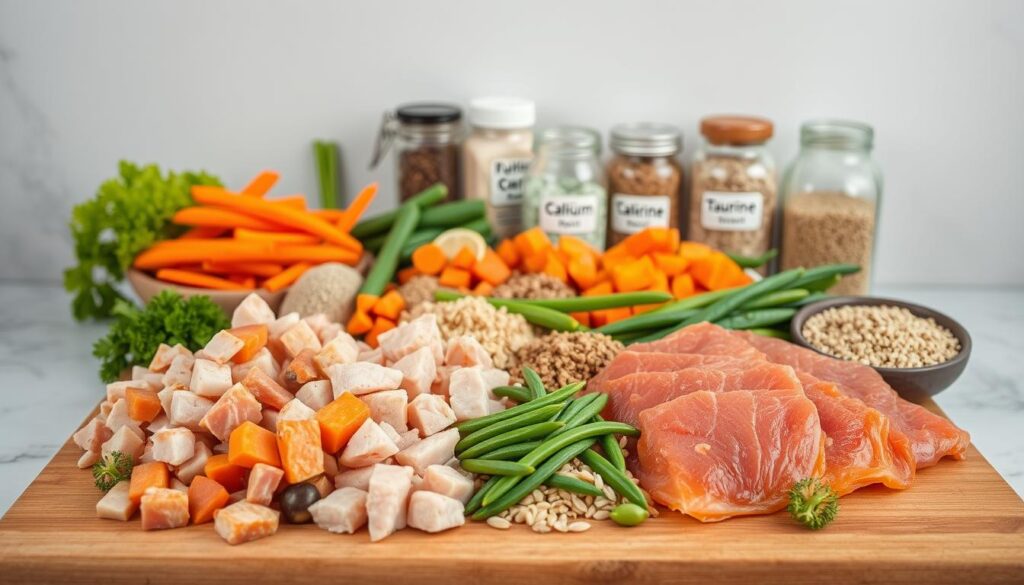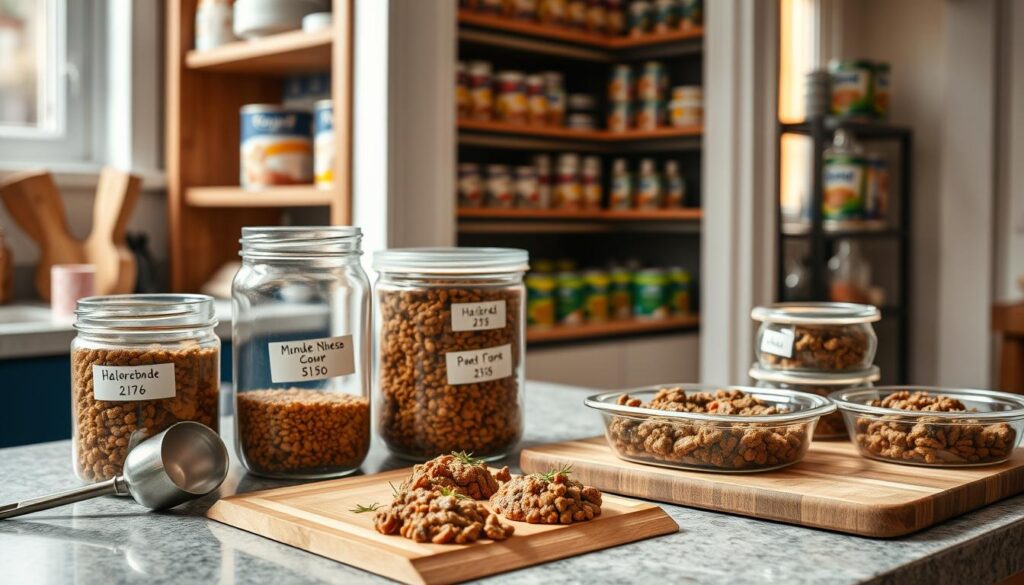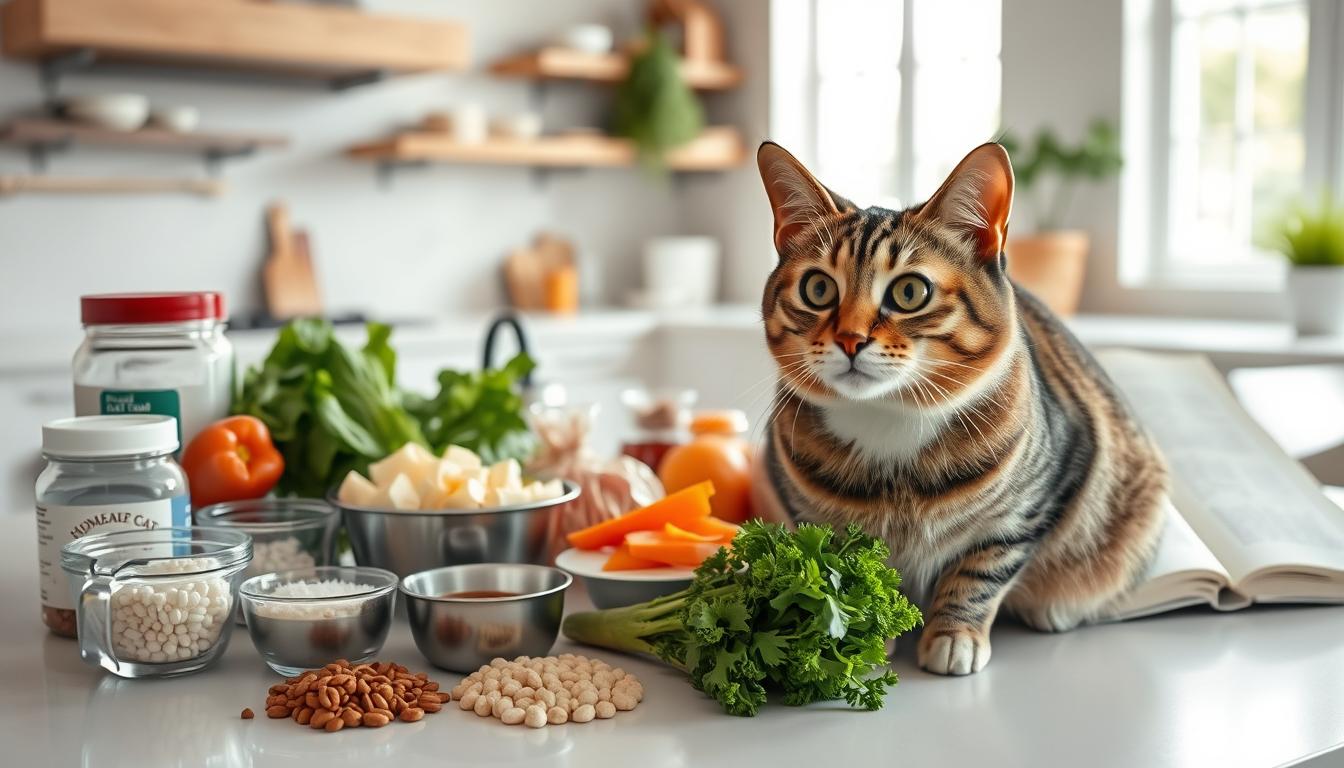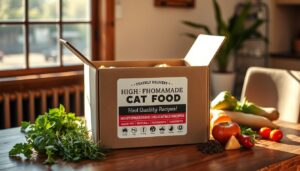As a pet owner, making sure your feline companion is healthy is very important. One good way to do this is by making nutritious homemade meals for your cat. But, you must know the risks of DIY cat food and how to keep your cat safe and healthy.
Making homemade cat food can be a great choice for your pet’s diet. But, you need to think about what your cat needs and the possible health risks. By following some key tips, you can make sure your cat’s meals are safe and healthy.
Key Takeaways
- Understand the nutritional needs of your cat
- Choose safe and healthy ingredients
- Avoid common mistakes in DIY cat food preparation
- Consult with a veterinarian for personalized advice
- Monitor your cat’s health and adjust their diet accordingly
The Benefits and Risks of Homemade Cat Food
More cat owners are making their pets’ food at home. This lets them control what goes into their cat’s meals. But, it’s important to know the risks and your cat’s needs.
Why Pet Owners Choose Homemade Options
Many choose homemade food to avoid bad stuff in store-bought cat food. They might also want to match their cat’s diet to their health needs. Homemade cat food can be healthier if done right.
Understanding the Responsibility of DIY Cat Food
Making cat food at home is a big job. You must make sure it’s good for your cat. Cats need the right mix of proteins, fats, vitamins, and minerals. A good homemade diet is great, but a bad one can harm your cat.
| Nutrient | Importance | Common Sources |
|---|---|---|
| Protein | Essential for muscle health | Chicken, Fish, Beef |
| Vitamin A | Crucial for vision and immune function | Liver, Fish Oil |
| Calcium | Necessary for bone health | Bone Meal, Dairy |
Balancing Convenience with Safety
Convenience is key, but safety comes first. Making sure your cat’s food is safe is very important. This means handling, cooking, and storing it right. Knowing the homemade cat food best practices helps keep your cat healthy.
Understanding Your Cat’s Nutritional Requirements
Cats need certain foods to stay healthy. A good diet keeps them full of energy and their fur shiny. It also helps their body work right.
Essential Proteins and Amino Acids
Proteins are very important for cats. They give them amino acids like taurine and arginine. These help their heart, eyes, and immune system.
Key amino acids and their benefits:
- Taurine: Supports heart health and vision.
- Arginine: Essential for the urea cycle and overall metabolism.
- Lysine: Important for immune function and overall health.
Vital Vitamins and Minerals
Cats need many vitamins and minerals to stay healthy. Vitamin A helps their eyes and immune system. Calcium and phosphorus are good for their bones.
| Vitamins/Minerals | Function | Sources |
|---|---|---|
| Vitamin A | Vision, immune function | Liver, fish oil |
| Calcium | Bone health | Dairy, bone meal |
| Phosphorus | Bone health, metabolism | Meat, fish |
Proper Nutrient Ratios for Optimal Health
Getting the right mix of nutrients is very important. The wrong mix can cause health problems. Talking to a vet nutritionist can help find the best mix for your cat.
“The key to a healthy homemade cat food recipe is balance. Ensuring that your cat receives the right amount of proteins, vitamins, and minerals is crucial for their overall health.”
Knowing what your cat needs helps them stay healthy. Homemade food can be a great choice if done right.
Safe Ingredients for Homemade Cat Food
When making homemade cat food, pick safe and healthy ingredients. The right ones help your cat stay healthy and avoid sickness.
Quality Protein Sources
Protein is key for cats. They need animal proteins because they are meat-eaters.
Poultry and Fish Options
Poultry and fish are great for cats. Chicken, turkey, and salmon give protein and amino acids. “Veterinary nutritionists say these are easy to digest and good for homemade cat food.”
Other Suitable Animal Proteins
Beef, lamb, and venison are also good. They add nutrients and variety to your cat’s diet.

Healthy Fats and Oils
Fats and oils give energy and keep skin and coat healthy. Salmon oil and chicken fat have omega-3s, which are good for cats.
Beneficial Supplements and Additives
Some supplements can make homemade cat food better. But, only use safe and needed ones for your cat’s health.
Taurine Supplementation
Taurine is important for cats’ hearts and eyes. Adding taurine helps prevent a lack of it in homemade food.
Calcium Sources
Calcium is key for strong bones. Use ground eggshells or bone meal for it. But, make sure to balance it with other minerals to avoid problems.
Choosing these safe ingredients helps make healthy homemade cat food. It supports your cat’s health and happiness.
Dangerous Ingredients to Avoid
To keep your cat safe, know which foods to avoid. Homemade cat food can be good but risky if not made right. Some human foods are toxic to cats.
Toxic Foods for Cats
Some foods that people eat can harm or even kill cats. Onions and garlic can hurt a cat’s red blood cells, causing anemia. Chocolate is also bad for cats because of its theobromine.
Common Kitchen Ingredients That Harm Cats
Onions and garlic are common but bad for cats. Even a little can make them very sick. Keep these out of your cat’s food.
Seasonings and Spices to Avoid
Many seasonings and spices are bad for cats. Salt and certain spices can make cats sick. Always check what’s in any seasoning blends.
Problematic Additives and Preservatives
Some additives and preservatives in cat food are bad. For example, BHA and BHT can harm cats. Avoid these when making homemade cat food.
Knowing about these dangers helps keep your cat safe. It makes sure their homemade food is good for them.
Homemade Cat Food Safety Tips
When you make food for your cat at home, safety is key. It’s rewarding to feed your cat homemade meals. But, you must follow safety steps to keep your cat healthy.
Kitchen Hygiene Protocols
Keeping your kitchen clean is the first step. Wash your hands well before you start. Make sure all tools and surfaces are clean and germ-free.
This stops harmful germs from spreading. Cleaning your kitchen and tools often is a good idea. Set up a cleaning schedule to keep things clean.
Safe Food Handling Practices
Handling food safely is very important. Always thaw frozen ingredients in the fridge or under cold water. Don’t thaw them at room temperature.
Use different cutting boards for meat and other foods. This stops germs from spreading. Store raw and cooked foods separately. Label and date everything so you use the oldest first.
Proper Cooking Methods and Temperatures
Cooking your cat’s food right is key to safety. Use a food thermometer to check meat’s temperature. Don’t undercook meat or poultry to avoid sickness.
By following these tips, you can make safe, healthy meals for your cat. Keep your kitchen clean, handle food safely, and cook at the right temperature. This way, you can give your cat the best homemade food.
Storage and Serving Guidelines
Storing and serving homemade cat food right is key. It keeps the food fresh and safe for your cat. Handling the food well stops spoilage and sickness.
Refrigeration Best Practices
Use airtight containers for homemade cat food in the fridge. This stops air and germs from getting in. Write the date on the container and keep it cold.
Freezing Techniques for Batch Preparation
Freezing is great for keeping homemade cat food fresh. Use containers or bags made for the freezer. Remove air to stop freezer burn. Label them with the date and what’s inside.

Safe Thawing and Serving Methods
Thaw frozen cat food in the fridge or cold water. Change the water every 30 minutes. Don’t thaw at room temperature to avoid germs.
After thawing, eat the food right away. Throw away leftovers that have been out for more than two hours.
Avoiding Bacterial Growth
Keep food clean to stop germs. Wash your hands before and after touching the food. Make sure all tools and surfaces are clean.
Proper Portion Control
Give the right amount of food to keep your cat healthy. Measure it carefully for your cat’s size and needs. Don’t feed too much to avoid weight problems.
By following these tips, your homemade cat food stays safe and healthy for your pet.
Transitioning Your Cat to Homemade Food
Changing your cat’s food to homemade needs care and slow steps. This is key for their health and happiness.
Creating a Gradual Transition Plan
Begin by adding a little homemade food to their usual diet. Slowly add more homemade food over 7-10 days. This helps their body get used to the new food.
Monitoring for Digestive Issues
Watch for signs like vomiting, diarrhea, or not wanting to eat. If you see these, slow down the change. Talking to your vet is smart if problems keep happening.
Adjusting Recipes Based on Your Cat’s Response
Look at your cat’s health after the change. Check their coat, energy, and stool. If they don’t like it, change the recipe. Finding the right mix might take some tries.
By being careful and watching your cat, you can make the switch to homemade food smoothly. This will help them stay healthy and happy.
Common Mistakes in Homemade Cat Food Preparation
Making homemade cat food can be fun, but it needs careful steps. Many cat owners want to feed their pets better. But, they might not know how to keep their cats healthy.
It’s important to get the right mix of nutrients and keep the food safe. This is key to making good homemade cat food.
Nutritional Imbalances and Deficiencies
Many people make mistakes with cat food. Cats need certain things to stay healthy. For example, not enough taurine can cause big problems like heart issues and bad eyesight.
It’s important to use different proteins and add supplements. This helps make sure your cat gets everything they need.
- Make sure to use animal proteins like chicken, fish, or beef.
- Add important vitamins and minerals, like vitamin A and calcium.
- Don’t add too much of anything, as it can be bad.
Talking to a vet nutritionist can help make a good recipe. It’s also important to check and change the recipe as needed.
Food Safety Oversights and Contamination Risks
Keeping food safe is very important. Raw ingredients can have harmful bacteria like Salmonella or E. coli. It’s key to handle and store food right to avoid these risks.
“Proper food handling and storage are crucial to prevent bacterial contamination in homemade cat food.”
To stay safe, follow these tips:
- Use clean tools and surfaces when cooking.
- Keep food in airtight containers in the fridge or freezer.
- Mark and date containers so you use the oldest first.
Knowing these mistakes and how to avoid them helps. Cat owners can then give their pets a healthy, safe, and tasty homemade diet.
Veterinary Collaboration and Health Monitoring
Keeping your cat healthy on homemade food needs teamwork with vets. This team effort is key to spotting diet gaps and fixing health issues fast.
Consulting with Veterinary Nutritionists
Vet nutritionists offer great advice on making healthy cat food at home. They know what your cat needs based on age, health, and how active they are.
Regular Health Check-ups and Bloodwork
It’s important to take your cat for regular health checks and blood tests. These steps help catch problems early. This way, you can change the food recipe if needed.
Adjusting Recipes Based on Health Needs
Your cat’s health needs can change over time. Working with your vet, you can tweak the homemade food recipe. This ensures it stays right for your cat’s diet.
| Health Monitoring Aspect | Importance | Frequency |
|---|---|---|
| Regular Check-ups | Early detection of health issues | Every 6 months |
| Bloodwork | Monitoring nutritional deficiencies | Annually |
| Dietary Adjustments | Ensuring ongoing nutritional balance | As needed based on health status |
Conclusion
Making homemade cat food is rewarding for pet owners. It gives cats a healthy diet. By following homemade cat food best practices, cats get the nutrients they need.
To make safe homemade cat food, know what your cat needs. Use safe ingredients and avoid bad additives. Keeping your kitchen clean and storing food right is key to avoid sickness and bad nutrition.
Working with vet nutritionists and watching your cat’s health is important. This way, you can change recipes if needed. This approach helps keep your cat healthy and happy for a long time.
Being careful with ingredients and how you prepare food is important. It makes homemade cat food safe and healthy for your cat.
FAQ
What are the most common nutritional deficiencies in homemade cat food?
Cats need certain nutrients like taurine, vitamin E, and arachidonic acid. A balanced recipe with the right supplements can help avoid these deficiencies.
How can I ensure my homemade cat food is safe from bacterial contamination?
Keep your kitchen clean and handle raw meat safely. Cook food well and store leftovers in airtight containers in the fridge or freezer.
Can I use regular human food as a substitute for my cat’s nutritional needs?
No, cats need different nutrients than humans. While some human foods are okay, a diet lacking feline nutrients can cause health problems. Talk to a vet nutritionist to make a balanced recipe.
How often should I consult with a veterinary nutritionist when preparing homemade cat food?
See a vet nutritionist at the start to make a balanced recipe. Then, check in periodically to make sure your cat’s needs are met.
What are some signs that my cat is not tolerating homemade cat food well?
Signs include diarrhea, vomiting, weight loss, lethargy, or skin problems. If you see these signs, talk to your vet to change the recipe.
How do I transition my cat to homemade food without causing digestive upset?
Start by mixing homemade food with their current food over 7-10 days. Watch their stool and health during this time.
Are there any specific ingredients that I should avoid in homemade cat food due to toxicity?
Yes, avoid onions, garlic, chives, leeks, grapes, raisins, and high-mercury fish. Also, watch out for xylitol, caffeine, and chocolate.
Can I add supplements to my cat’s homemade food, and if so, which ones are beneficial?
Yes, omega-3 fatty acids, vitamin E, and taurine are good. But, talk to a vet nutritionist to find the right supplements for your cat.
How should I store homemade cat food to maintain its freshness and safety?
Use airtight containers in the fridge for 3-5 days or freeze for longer. Always label containers with the date and what’s inside.




